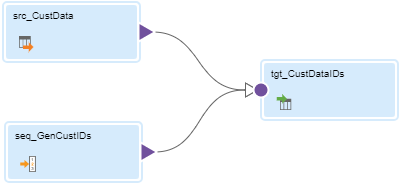
Property | Description |
|---|---|
Use Shared Sequence | Enable to generate sequence values using a shared sequence. When enabled, the sequence starts with the Current Value of the shared sequence. For information about shared sequences, see Components. Default is disabled. |
Increment By | The difference between two consecutive values in a generated sequence. For example, if Increment By is 2 and the existing value is 4, then the next value generated in the sequence will be 6. Default is 1. Maximum value is 2,147,483,647. |
End Value | Maximum value that the mapping task generates. If the sequence reaches this value during the task run and the sequence is not configured to cycle, the run fails. Maximum value is 9,223,372,036,854,775,807. If you connect the NEXTVAL field to a downstream integer field, set the End Value to a value no larger than the integer maximum value. If the NEXTVAL exceeds the data type maximum value for the downstream field, the mapping run fails. In advanced mode, set the end value to at least the maximum number of rows that you process. |
Initial Value | The value you want the mapping task to use as the first value in the sequence. If you want to cycle through a series of values, the value must be greater than or equal to the Start Value and less than the End Value. Default is 1. |
Cycle | If enabled, the mapping task cycles through the sequence range. If disabled, the task stops the sequence at the configured End Value. The session fails if the task reaches the End Value and still has rows to process. Default is disabled. |
Cycle Start Value | Start value of the generated sequence that you want the mapping task to use if you use the Cycle option. When the sequence values reach the End Value, they cycle back to this value. Default is 0. Maximum value is 9,223,372,036,854,775,806. |
Number of Cached Values | Number of sequential values the mapping task caches for each run. Each subsequent run uses a new batch of values. The task discards unused sequences for the batch. The mapping task updates the repository as it caches each value. When set to 0, the task does not cache values. Use this option when multiple partitions use the same Sequence transformation at the same time to ensure each partition receives unique values. Default is 0. This option is not available when the Cycle property is enabled. In advanced mode, you can't set the number of cached values. However, your organization administrator can optimize how values are cached. For more information, contact Informatica Global Customer Support. (Ref 619019) |
Reset | If enabled, the mapping task generates values based on the original Initial Value for each run. Default is disabled. |
Property | Description |
|---|---|
Tracing Level | Detail level of error and status messages that Data Integration writes in the session log. You can choose terse, normal, verbose initialization, or verbose data. Default is normal. |
Optional | Determines whether the transformation is optional. If a transformation is optional and there are no incoming fields, the mapping task can run and the data can go through another branch in the data flow. If a transformation is required and there are no incoming fields, the task fails. For example, you configure a parameter for the source connection. In one branch of the data flow, you add a transformation with a field rule so that only Date/Time data enters the transformation, and you specify that the transformation is optional. When you configure the mapping task, you select a source that does not have Date/Time data. The mapping task ignores the branch with the optional transformation, and the data flow continues through another branch of the mapping. |
Disable incoming fields | Disable incoming fields to connect only the generated sequence to a downstream transformation. If you disable incoming fields, you must connect at least one field from another transformation to the downstream transformation. |
